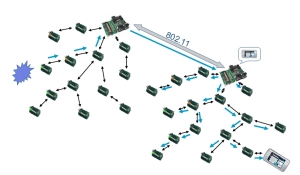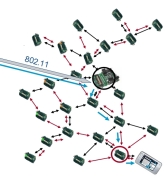Our research objective is to route data to mobile sinks under hard latency constraints. One way to address latency constraints it to decrease the distance that data has to travel along the low-bandwidth 805.15.4 links. We address this problem in our two-tier architecture by routing data from sensors (data sources) to their cluster-heads first. Cluster-heads then cooperate to find a cluster where the user (data sink) is located and deliver data to this cluster over high bandwidth 802.11 links. Data packets again travel along 805.15.4 links in the final part of the route.
From the networking point of view, routing data from a data source to its cluster-head is straightforward: any collection tree protocol works fine. However, a number of alternatives exists for transmitting data from a cluster-head to a sink. We are currently exploring a cluster-wide flooding, point-to-point routing, route-to-sink along collection tree and sink-centered collection tree approaches.

Cluster-wide flood routing

Path-to-sink routing |

Sink-centered CTP routing |
|

